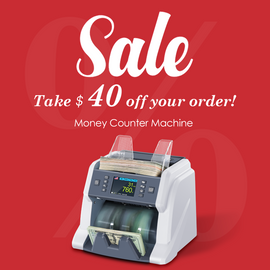Counterfeiting money is a severe crime, and banks take extra measures to ensure they don’t accept counterfeit bills. But how do banks check for fake bills?This article explains the different methods banks use to detect counterfeit bills and prevent them from entering circulation.
How Do Banks Check For Counterfeit Bills?
Banks are required to check for counterfeit bills when they receive them from customers. If the bank finds a counterfeit bill, it will be removed from circulation and destroyed. Banks use several methods to detect counterfeit bills:
Train bank cashiers to learn the difference between genuine and counterfeit bills and how to identify them
Bank cashiers are trained to detect suspicious banknotes. They use their eyes and hands to look for signs of counterfeiting, such as printing smudges or blurriness, inconsistent serial numbers, uneven edges, and other irregularities. Bank cashiers may also carefully compare the banknotes they receive with known genuine samples.
Use counterfeit detector pens to check for counterfeit bills
Banks use counterfeit detector pens to examine security features on banknotes. These pens contain ink that reacts differently when applied to genuine paper versus counterfeit currency. You can check out this article Why Counterfeit Pens Are Not A Reliable Way To Detect Fake Money to know how these pens work specifically.
Use counterfeit bill detector machines to detect counterfeit bills
Some banks use specialized counterfeit bill detectors to detect counterfeit bills quickly. These machines are usually equipped with ultraviolet light emitters. Since many banknotes have unique designs and patterns that can only be seen under UV light, bank staff use this machine to examine cash and look for these hidden patterns to determine whether the banknotes received are counterfeit.
Use money counter machines to detect counterfeit bills
Some banks also use more convenient money counting machines that combine counting, sorting and counterfeit detection technologies. These machines use a combination of multiple technologies, such as image sensor technology and magnetic detection technology, to provide more reliable security.
Other methods of detecting counterfeit currency
- Magnetic Ink Character Recognition (MICR): MICR technology uses magnetic inks and special printers to create unique codes on the bottom of each bill. The codes are scanned by machines and compared against a database of valid bills to verify their authenticity.
- Watermark Verification: Most bills have a subtle watermark embedded in the paper. To verify the watermark, bank employees hold the bill up to a light source and look for the watermark on the other side.
- Microscopic Examination: Bank employees use powerful microscopes to examine the tiny details on each bill, such as the printing, serial numbers, and design elements.
Conclusion
In conclusion, banks employ various methods to detect and prevent counterfeit bills from entering circulation. These methods include training bank cashiers to recognize the differences between genuine and counterfeit bills, using counterfeit detector pens and counterfeit bill detector machines, and utilizing money counter machines with advanced detection technologies. Other techniques, such as Magnetic Ink Character Recognition (MICR), watermark verification, and microscopic examination, further ensure the accuracy and security of currency transactions. By utilizing these methods, banks can ensure that only genuine currency is accepted and circulated, thus protecting the financial system's integrity.







